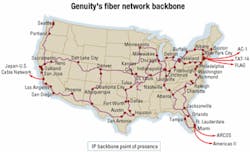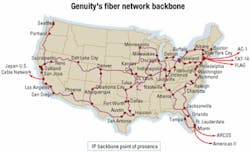Verizon moves to thwart competitors, expanding deeper into ILEC territories
By ROBERT PEASE
First, it was Dallas/Fort Worth, then Seattle, and now Los Angeles. Although Verizon (New York City) may not be commenting on where it will strike next, there's a definite pattern in the company's expansion plan to move beyond its local serving areas and into the nationwide enterprise business arena. The company is expanding its existing network into central business districts traditionally served by the former GTE before merging with Bell Atlantic to form Verizon.
The move might also be viewed as retaliatory, since Verizon has seen its traditional service territory threatened by carriers like Qwest Communications (Littleton, CO) and Southwestern Bell (SBC Communications-San Antonio, TX). To deal with the threat, Verizon went on the offensive by targeting specific cities where the company has established an incumbent local-exchange-carrier (ILEC) presence, expanding services to large business customers-first with data transport services over DWDM and SONET, then with switched-based services, including voice, frame relay, and ATM.
"Businesses want one-stop shopping, so we are extending our network to their doorsteps," says Eduardo Manasce, president of Verizon's Enterprise Solutions Group. "With no handoffs, we now can deliver data to and from these local customers anywhere on Verizon's network."
By leveraging some key relationships with Metromedia Fiber Network (MFN-New York City) and Genuity Inc. (Woburn, MA), along with assets gained from the Bell Atlantic/GTE merger, Verizon can make good on its claim to provide a complete set of communications solutions. Dark fiber in many metropolitan areas is provided through MFN, while long-haul transport can be handled over Genuity's national fiber-optic backbone network (see Figure).
The projects
"Three markets were identified for the initial expansion: Dallas, Seattle, and Los Angeles," says Makonnen E. Makonnen, executive director for near out-of-franchise implementation at the Enterprise Solutions Group. "Dallas was announced in July 2001, Seattle in December 2001 and, most recently, Los Angeles. Phase II cities are currently under consideration."
"Unlike many competitors in the telecom field that have tried to expand into the heart of an RBOC region, Verizon is well-positioned to effectively compete against the incumbent," says Jason Knowles, a network services analyst with Current Analysis (Sterling, VA). "Verizon is only entering new markets with a laser-beam approach. The company will only enter markets where it can relatively quickly provide customers with a complete communications solution with its established strong brand name."
In Seattle, Verizon is providing services over a new fiber-optic network in the downtown area. Target customers include large business and government organizations requiring dedicated high-speed, high-capacity transport services as well as additional data services, long-distance voice, and managed-network solutions.
"Verizon is in a strong position to compete against Qwest," says Knowles. "Verizon has brand-name recognition throughout the greater Seattle area, given its ILEC status. The company is also financially sound. Offering a complete communication solution may be reassuring to customers at a time when even the IXCs [interexchange carriers] appear to be in turmoil."
Focused, limited expansion
Verizon's expansion plan is cautious and calculated. By focusing on cities where the company has an ILEC presence and offering new services where the capability exists due to established market presence, Verizon tips the scales of success in its favor. But there are some potential obstacles.
For instance, the very fact that Verizon is perceived as an ILEC may discourage potential customers, since many businesses may be reluctant to turn to the ILEC that also serves their suburban home for robust business services. The lack of a long-haul network of its own could also hinder the process, although the partnership with Genuity is strong and, according to Makonnen, can actually be an economic advantage in that this type of expansion minimizes Verizon's financial capital outlay.
"It's also important to note that Verizon is not expanding into these markets as a CLEC [competitive local-exchange carrier]," says Knowles. "It is leveraging its ILEC infrastructure to expand as an ILEC. This is why you'll only see Verizon expand into a very select group of markets. While Verizon's focused approach is admirable, we believe the company needs to take some risks and venture into cities where it does not have an ILEC presence, infrastructure, or brand name."
In light of today's economically strained times, when many companies have opted to put their expansion plans on hold, Verizon's approach is limiting the company's risk. But what happens when businesses want direct transport links to branch offices in cities like Chicago and Denver-cities without a Verizon presence?
"Looking forward, Verizon is evaluating additional cities for U.S. expansion and will actively seek to expand internationally," says Makonnen. "Once again, our mantra will be 'follow our customers.' "
Verizon appears content to take the more cautious approach for now and expand its existing territories. Perhaps later, when the economy recovers and money begins to exchange hands more easily, Verizon and other carriers will more aggressively reach out with fiber technology to meet the still-growing speed and capacity demands of business and commercial customers-everywhere.

